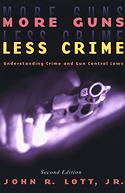After the shooting at city hall on Wednesday, banning citizens with guns from public areas seems more necessary than ever. Yet, many other city halls across the country take a radically different approach. In two neighboring states, Pennsylvania and Vermont, as well as states across the nation from Virginia to Washington, concealed handgun permit holders are allowed to take their guns with them when they attend city council meetings.
Gun-free zones may appear like the obvious solution to New Yorkers, but consider an analogy: Suppose a criminal is stalking you or your family. Would you feel safe putting a sign in front of your home saying, “This Home Is a Gun-Free Zone”? Law-abiding citizens might be pleased by such a sign, but to criminals it is an invitation.
In 1985, just eight states had right-to-carry laws — laws that automatically grant permits for concealed weapons once applicants pass a criminal background check, pay their fees and (when required) complete a training class. Today, 35 states do.
Examining all the multiple-victim public shootings from 1977 to 1999 shows that, on average, states that adopt right-to-carry laws experience a 60 percent drop in the rate at which the attacks occur, and a 78 percent drop in the rate at which people are killed or injured from such attacks.
To the extent that such attacks still occurred in right-to-carry states, they overwhelmingly took place in so-called “gun-free zones.” Interestingly, the five shootings that Newsday lists as having occurred in or near American city halls since 1950 have all taken place in “gun-free zones.”
The effect of right-to-carry laws is greater on multiple-victim public shootings than on other crimes, and for a simple reason: Increasing the probability that someone will be able to protect himself improves deterrence. Though it may be statistically unlikely that any person in particular in a crowd is carrying a concealed handgun, the probability that at least one person is armed is high.
For these attacks, the most important factor in determining the amount of harm is the length of time between the start of the attack and when someone with a gun can stop the attack. The longer the delay, the more people are harmed. By reducing the number harmed, right-to-carry laws take away much of the benefit these warped minds think they are achieving by their attack.
 Othniel Boaz Askew’s crime at City Hall is somewhat different in that the attacker had only one target in mind, but the vast majority of academic research finds that concealed handguns reduce violent crime generally. Despite all the national studies that have been done, there is not a single refereed academic journal publication concluding the opposite. The experience in states with right-to-carry laws indicates that permit holders are extremely responsible and extremely law-abiding. Accidental gun deaths simply have not increased after states adopt these laws, and permit holders lose their permits for even the most trivial firearms-related violations at hundredths or thousandths of a percent.
Othniel Boaz Askew’s crime at City Hall is somewhat different in that the attacker had only one target in mind, but the vast majority of academic research finds that concealed handguns reduce violent crime generally. Despite all the national studies that have been done, there is not a single refereed academic journal publication concluding the opposite. The experience in states with right-to-carry laws indicates that permit holders are extremely responsible and extremely law-abiding. Accidental gun deaths simply have not increased after states adopt these laws, and permit holders lose their permits for even the most trivial firearms-related violations at hundredths or thousandths of a percent.
 Police are important in deterring crime, but they almost always arrive after the crime has been committed. In this case punishment after the fact is particularly useless, since Askew, who was apparently dying from AIDS, is reported to have apparently “made meticulous preparations for his own death.”
Police are important in deterring crime, but they almost always arrive after the crime has been committed. In this case punishment after the fact is particularly useless, since Askew, who was apparently dying from AIDS, is reported to have apparently “made meticulous preparations for his own death.”
Annual surveys of crime victims in the United States by the Justice Department show that when confronted by a criminal, people are safest if they have a gun.
Good intentions do not necessarily make good laws. What counts is whether the laws ultimately save lives. The new rules that prohibit lawful gun-owners from carrying concealed guns at City Hall might actually wind up costing more lives, rather than saving them.



